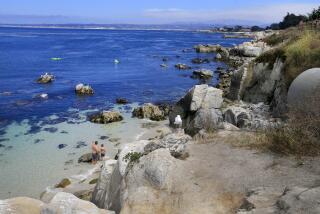Long Beach entrepreneur has fresh idea for shellfish farm
On a recent sunny morning off Long Beach, Philip Cruver throttled down his boat at the spot where his company expects to develop the first shellfish ranch in federal waters.
“Our goal is to show this can be done and put a dent in the nation’s $10.4-billion seafood deficit,” Long Beach entrepreneur Cruver, 67, explained from the deck of his 27-foot vessel.
If all goes according to plan, construction of a pilot 100-acre underwater plot will begin early next year, with the first harvest of a half a million pounds of plump Mediterranean mussels and 500,000 Pacific oysters expected about eight months later. The shellfish, which clean seawater as they filter microscopic plankton from the ocean to feed themselves, would be cultivated by the tens of thousands from “seed” planted on submerged lines of rope and hanging nets.
Shellfish aquaculture has for decades stayed close to shore in the United States — in waters regulated by the states — because the environment is rich in nutrients and the farms are near maintenance operations, distribution systems and customers.
Cruver sees advantages in placing a farm farther from shore, 1.5 miles beyond the 3-nautical-mile boundary of California state water. He believes shellfish cultivated in the open ocean would produce higher growth rates, better meat yields and heavier production than shellfish farms close to shore.
Cruver says deeper waters also can provide a constant food supply, less affected by tides than farms closer to land. In addition, the shellfish would mature while suspended in deep water and swift currents, avoiding infestation by parasites found in shallow bays and estuaries. His long-term plan is to expand from the pilot project to 1,000 acres.
TheU.S. Army Corps of Engineershas issued a provisional permit for Cruver to build his KZO Sea Farms operation in federal water. All that remains is approval from the California Coastal Commission.
On Tuesday, the commission requested additional information on the makeup of the anchors, flotation devices, ropes and nets the farm would use, how they would be installed and monitored, and the manner in which harvesting would be carried out.
Of particular concern to the commission is the potential effect on fisheries and habitat resulting from marine debris, ship strikes and entanglement of whales, dolphins, porpoises and sea turtles. However, commission environmental scientist Cassidy Teufel said in an interview that the project design appeared flexible enough to adapt to contingencies.
The commission is expected to make a final decision later this year.
KZO has partnered with the USC Wrigley Institute of Environmental Studies on Santa Catalina Island for monitoring environmental effects and conducting research on advanced breeding techniques. Although coastal shellfish farms have been in operation in Japan, New England and the Northwestern United States for more than a century, little research has been done on the development of new, fully domesticated strains of faster-growing oysters and mussels.
Institute geneticist Dennis Hedgecock described the proposed project as “a milestone in aquaculture — and about as green a way of producing protein for human consumption as one can imagine. That is because oysters and mussels filter water naturally as they feed on microscopic plankton.”
Michael Rubino, director of the National Oceanic and Atmospheric Administration’s office of aquaculture, said Cruver’s project is consistent with the agency’s mission — creating jobs, providing nutritional food and improving the marine environment by putting shellfish back in the water. “Add experienced local operators to the mix and you’ve got a winning combination,” Rubino said.
KZO’s management team includes Bernard Friedman, owner of Santa Barbara Mariculture, a successful 70-acre shellfish farm about three-quarters of a mile offshore. Essentially, KZO aims to create a large-scale version of Friedman’s operation, which grows shellfish on submersible long-lines originally developed by the Japanese.
KZO plans to grow oysters and mussels on 45 lines, each about 500 feet long, spaced 100 feet apart and anchored to the ocean floor. Coast Guard-approved buoys equipped with battery-powered lights would suspend the long-lines 30 feet beneath the surface, well out of the way of boaters.
More to Read
Start your day right
Sign up for Essential California for news, features and recommendations from the L.A. Times and beyond in your inbox six days a week.
You may occasionally receive promotional content from the Los Angeles Times.






